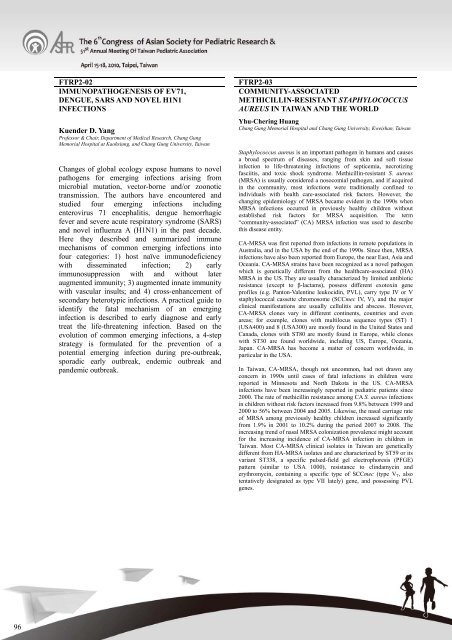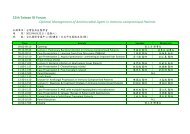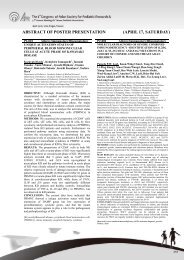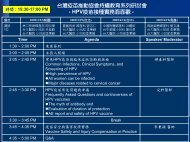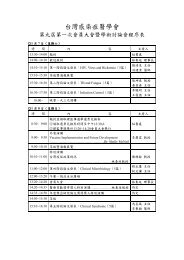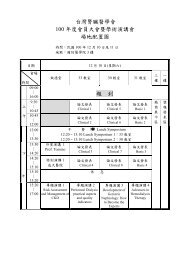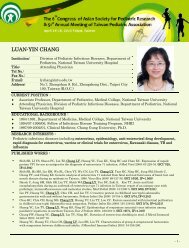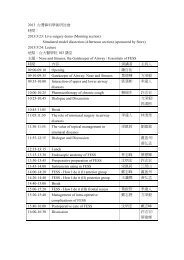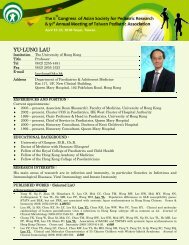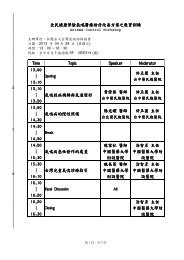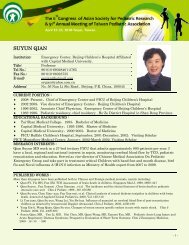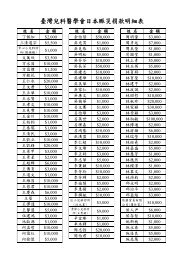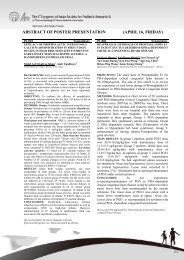FTRP1-04MOLECULAR <strong>AND</strong> GENETICINVESTIGATION ON AUTOIMMUNEDIABETES: FROM MECHANISMDISSECTION TO CLINICAL APPLICATIONHuey-Kang Sytwu, MD, PhDGraduate Institute of Microbiology and ImmunologyNational Defense Medical Center, Taipei, TaiwanInsulin-dependent diabetes mellitus (IDDM), or type I diabetes, isa T cell-mediated autoimmune disease. A widely used animalmodel for dissecting immunopathologic mechanisms in IDDMand developing preventive and/or therapeutic strategies is thenon-obese diabetic (NOD) mouse, an inbred strain thatspontaneously develops autoimmune diabetes resembling humanIDDM. To directly dissect the immunopathogenic mechanisms oftype I diabetes and to develop potential therapeutic strategy forthis autoimmune disease, we have already established severalnovel transgenic and knockout NOD mice in our lab: one is theTh1 and Th2 double transgenic NOD mouse which provides thebest in vivo model to study the pathogenic nature and thedifferentiation of helper T cell subsets during the diabetogenicprocess in IDDM;the other is the IL-12 knockout NOD mousewhich provides the best model to investigate directly theregulation of IL-12 on autoimmune response in NOD mice. Tofurther delineate the protective roles of some novel immunemodulatory molecules, such as soluble decoy receptor 3 (DcR3),cytotoxic T lymphocyte antigen 4 (CTLA4), program death ligand1 and 2 (PD-L1 and 2), heme oxygenase 1 (HO-1), in theautoimmune process and search for potential preventive and/ortherapeutic targets in this disease, we generated (a) insulinpromoter (pIns)-sDcR3 transgenic NOD mice, (b) pIns-singlechain anti-CTLA4 transgenic NOD mice, (c) pIns-single chainanti-4-1BB transgenic NOD mice, (d) pIns-PD-L1 transgenicNOD mice (e) pIns-PD-L2 transgenic NOD mice (f) pIns-HO-1transgenic NOD mice. Making full use of these unique mousestrains, we are quantitatively and qualitatively investigating theimmunopathogenic mechanisms of autoimmune diabetes andprovide valuable information for the development of novelimmunotherapies. Meanwhile, by using the established lenti-viralsystem in our lab, we are currently transducing variousimmunomodulatory genes into islets and investigating the functionand survival of these genetically modified graft islets. This mayprovide tremendous help for successful islet transplantation in thefuture. Finally, we are also generating target gene-specificlenti-siRNA-mediated knockdown NOD mice and investigatingpotential role of those genes in immunopathogenic process in typeI diabetes. To delineate further the potential roles of (1) somenovel immunopathogenic cytokines, such as IL-23 and IL-27; (2)some immunomodulatory receptors such as TLR-4; (3) some Th1response-inducing genes, such as T-bet, or STAT1/4, inautoimmune diabetes, we generated functional knockdown NODmice insufficient for those genes via direct lenti-siRNAtransduction or direct microinjection of shRNA constructs in NODembryos. Now we already obtained IL-23 and IL-27 knockdownNOD mice and currently investigate their phenotypes. These novelknockdown NOD mice will provide the best models to investigatedirectly the regulation of those genes on autoimmune immuneresponse in NOD mice.FTRP2-01STUDIES FROM ENTEROVIRUS 71 INFECTIONSTO KAWASAKI DISEASE IN TAIWANLuan-Yin CHANGAttending Physician, Division of Pediatric Infectious Disease, Department ofPediatrics, National Taiwan University Hospital, TaiwanThe enterovrius 71 (EV71) outbreak in Taiwan in 1998 is very well-knownto cause a lot of fatal children cases. In 1998 epidemic, there were 405severe cases with 78 deaths. In 2000 to 2002, there were still dozens of fatalEV71 cases each year. In addition, in 2008 EV71 outbreak occurred againin Taiwan as well as in mainland China and there were hundreds of severecases and dozens of fatal cases. A stage-based management was thusdeveloped to reduce the case-fatality but most survivors of brainstemencephalitis plus cardiopulmonary failure might have neurologic sequelaeand impaired cognition.We studied 433 family members from 94 families in which EV71 positivelyisolated. The overall enterovirus 71 transmission rate of household contactswas 52% (176/339): 84% (70/83) siblings, 83% (19/23) cousins, 41%(72/175) parents, 28% (10/36) grandparents and 26% (5/19) uncles/aunts.So, enterovirus 71 household transmission rates are high for children,medium for parents and low for other adults. Being male and being lessthan 6 years old were associated with increased risk of EV71 infection.Continuous EV71 disease and laboratory surveillance is warranted to allowfor possible earlier control and prevention measures.Kawasaki disease (KD) is the most important worldwide acquired heartdisease in children after the incidence of rheumatic heart disease isdecreasing during the recent decades. There is some mystery in KD such asdifferent incidences in different countries, the easy involvement of coronaryarteries and the unsolved infectious pathogen. We propose that infectionwith a single pathogen or infection with certain pathogens may triggerKawasaki disease in certain hosts (more in the male, young children, andthe oriental), and the infection may be transmitted within households, andthe majority have only mild illness but only a small percentage of childrenwith certain host genetics will develop Kawasaki disease.To investigate the infectious etiology of Kawasaki disease, a prospectivecase and household cohort study for Kawasaki disease is ongoing. The KDcases received virological isolation, molecular workup includingpolymerase chain reaction (PCR) for pan-enterovirus, pan-coronavirus,rhinovirus, metapneumovirus, pan-adenovirus and other possible viruses,cDNA RDA (representational difference analysis-subtractive cloning),VIDSICA (virus discovery based on the cDNA amplified restriction-lengthpolymorphism) and viral gene chips for unknown pathogens, bacterialculture (blood, throat swabs and stool: bacterial culture and stored strain forfurther toxin or superantigen detection), and serological workup for themost potential pathogen. Household members of KD cases were asked toundergo screening by virus isolation of throat swabs, and received the firstblood sample during acute illness of the KD case, and second blood sampleduring the convalescent stage of the KD case. If specific potential pathogenis found in Kawasaki cases, samples from the household members will beworkup for the specific pathogen.Till now, a total of 229 KD cases and about 900 of their household membershave been enrolled. During 1 to 10 days prior to their KD illness, 53.9%cases had contact with ill household members, and 10.3% had positivecontact with extra-familial ill people. In 59% families, at least one otherfamily member had illness after KD cases’ disease onset.95
FTRP2-02IMMUNOPATHOGENESIS <strong>OF</strong> EV71,DENGUE, SARS <strong>AND</strong> NOVEL H1N1INFECTIONSKuender D. YangProfessor & Chair, Department of Medical Research, Chang GungMemorial Hospital at Kaohsiung, and Chang Gung University, TaiwanChanges of global ecology expose humans to novelpathogens for emerging infections arising frommicrobial mutation, vector-borne and/or zoonotictransmission. The authors have encountered andstudied four emerging infections includingenterovirus 71 encephalitis, dengue hemorrhagicfever and severe acute respiratory syndrome (SARS)and novel influenza A (H1N1) in the past decade.Here they described and summarized immunemechanisms of common emerging infections intofour categories: 1) host naïve immunodeficiencywith disseminated infection; 2) earlyimmunosuppression with and without lateraugmented immunity; 3) augmented innate immunitywith vascular insults; and 4) cross-enhancement ofsecondary heterotypic infections. A practical guide toidentify the fatal mechanism of an emerginginfection is described to early diagnose and earlytreat the life-threatening infection. Based on theevolution of common emerging infections, a 4-stepstrategy is formulated for the prevention of apotential emerging infection during pre-outbreak,sporadic early outbreak, endemic outbreak andpandemic outbreak.FTRP2-03COMMUNITY-ASSOCIATEDMETHICILLIN-RESISTANT STAPHYLOCOCCUSAUREUS IN TAIWAN <strong>AND</strong> THE WORLDYhu-Chering HuangChang Gung Memorial Hospital and Chang Gung University, Kweishan, TaiwanStaphylococcus aureus is an important pathogen in humans and causesa broad spectrum of diseases, ranging from skin and soft tissueinfection to life-threatening infections of septicemia, necrotizingfasciitis, and toxic shock syndrome. Methicillin-resistant S. aureus(MRSA) is usually considered a nosocomial pathogen, and if acquiredin the community, most infections were traditionally confined toindividuals with health care-associated risk factors. However, thechanging epidemiology of MRSA became evident in the 1990s whenMRSA infections occurred in previously healthy children withoutestablished risk factors for MRSA acquisition. The term“community-associated” (CA) MRSA infection was used to describethis disease entity.CA-MRSA was first reported from infections in remote populations inAustralia, and in the USA by the end of the 1990s. Since then, MRSAinfections have also been reported from Europe, the near East, Asia andOceania. CA-MRSA strains have been recognized as a novel pathogenwhich is genetically different from the healthcare-associated (HA)MRSA in the US. They are usually characterized by limited antibioticresistance (except to β-lactams), possess different exotoxin geneprofiles (e.g. Panton-Valentine leukocidin, PVL), carry type IV or Vstaphylococcal cassette chromosome (SCCmec IV, V), and the majorclinical manifestations are usually cellulitis and abscess. However,CA-MRSA clones vary in different continents, countries and evenareas; for example, clones with multilocus sequence types (ST) 1(USA400) and 8 (USA300) are mostly found in the United States andCanada, clones with ST80 are mostly found in Europe, while cloneswith ST30 are found worldwide, including US, Europe, Oceania,Japan. CA-MRSA has become a matter of concern worldwide, inparticular in the USA.In Taiwan, CA-MRSA, though not uncommon, had not drawn anyconcern in 1990s until cases of fatal infections in children werereported in Minnesota and North Dakota in the US. CA-MRSAinfections have been increasingly reported in pediatric patients since2000. The rate of methicillin resistance among CA S. aureus infectionsin children without risk factors increased from 9.8% between 1999 and2000 to 56% between 2004 and 2005. Likewise, the nasal carriage rateof MRSA among previously healthy children increased significantlyfrom 1.9% in 2001 to 10.2% during the period 2007 to 2008. Theincreasing trend of nasal MRSA colonization prevalence might accountfor the increasing incidence of CA-MRSA infection in children inTaiwan. Most CA-MRSA clinical isolates in Taiwan are geneticallydifferent from HA-MRSA isolates and are characterized by ST59 or itsvariant ST338, a specific pulsed-field gel electrophoresis (PFGE)pattern (similar to USA 1000), resistance to clindamycin anderythromycin, containing a specific type of SCCmec (type V T , alsotentatively designated as type VII lately) gene, and possessing PVLgenes.96


